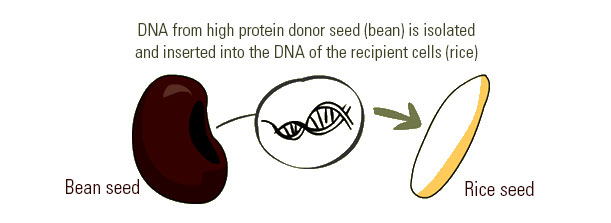- Genetic Engineering
How is genetic engineering done?
Let us see this scenario:
A scientist wants to produce a rice seed with higher protein content.

First, he identifies a plant with a high protein content characteristic, such as a bean. Then he studies the genetic make-up of that bean carefully. The bean seed is called the donor organism.
Next, he finds a viable rice seed and studies its DNA carefully too. He has to understand how to insert the DNA from the bean seed into the rice seed. The rice seed is the recipient organism.
Next, he isolates the genes from the donor organism, the bean. This process is called mapping. This genetic isolation is done to take out only the desired protein-making trait (or DNA).
He makes several copies of the bean gene and inserts them into the gene structures of the rice. This is a carefully orchestrated laboratory process, and many attempts are made to get it working right. This process is called Transformation.
The new gene (now called a transgene), with the desired trait, is transferred into the recipient cells (rice cells). This process is aided by some special bacterium and equipment. The scientist then ensures that the new genes are properly fixed in the cell structure of the seed.
Once genetic engineering is complete, traditional breeding can continue normally, and the new seeds from the parent plant will have the new gene or DNA structure. This means traditional breeding will continue, and the genetic engineering only added some new or desirable traits to the collection.
In 2013, a GM maize brand that was engineered for animals found its way into the market for human consumption. Although it is not clear if it was safe for human consumption, the fact remains that many more unauthorized GM brands can similarly get into the market.
